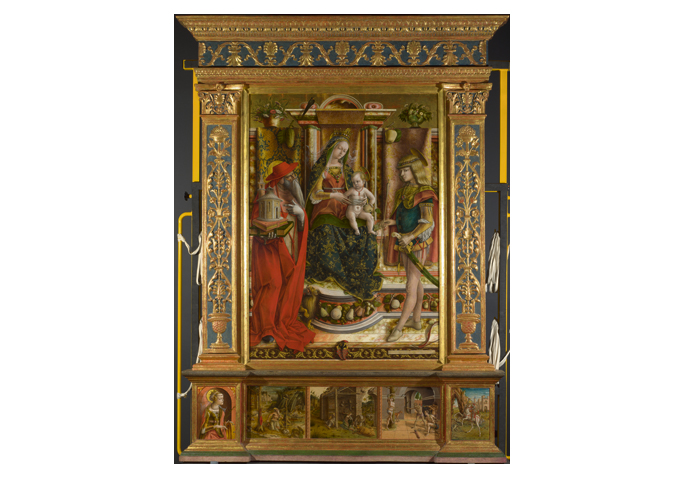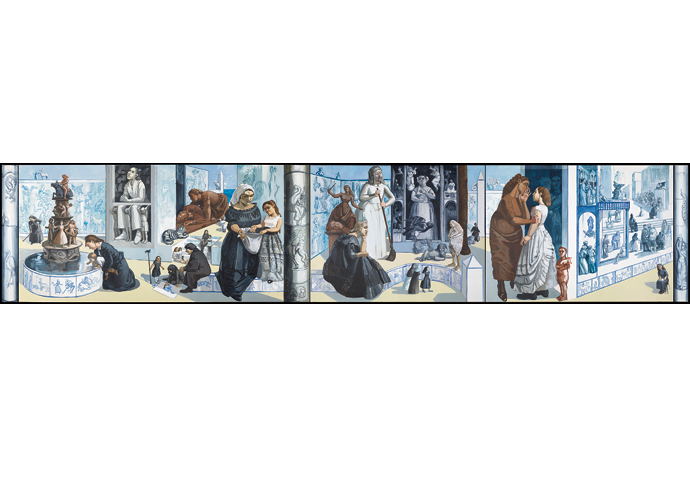
Carlo Crivelli, Altarpiece from S. Francesco dei Zoccolanti, Matelica, after 1490, © The National Gallery, London
SAINT Sebastian is being pierced by the arrows from extremely close range by an archer and a crossbowman, while a second archer is reloading.
St Catherine meanwhile is pictured as a truly tortured soul, complete with fearful expression and a wheel with sharp blades.
These are a couple of the stark images from Carlo Crivelli (c 1430/5 – c 1494) on his altarpiece La Madonna della Rondine (The Madonna of the Swallow, after 1490).
It’s now hanging in a new exhibition at the National Gallery* having acted as a source of inspiration for Paula Rego, the Lisbon-born, Kentish Town-based painter, who died in June last year at the age of 87.
Dame Paula, as she became, was the first Associate Artist at the National Gallery in 1990-1992, with a wide working brief and a studio in the building’s basement.
She explained: “I could creep upstairs and snatch at things, and bring them down with me to the basement, where I could munch away at them. And what I brought down here from upstairs varied a lot, but I always brought something into my den.”

Paula Rego, Crivelli’s Garden, 1990-1, acrylic on canvas, 190 x 944.6 x 2cm, The National Gallery, London. Presented by English Estates, 1991, © Ostrich Arts Ltd [The National Gallery, London]
And one stand-out piece she created is the fantastical, nearly 10-metre, acrylic on display alongside the 15th-century altarpiece. The difference, of course, and immediately obvious is the personnel. In this Rego painting, titled Crivelli’s Garden, we see a series of women, as exhibition curator Priyesh Mistry explains: “Dame Paula Rego’s radical painting has consistently given women a voice over repression in a male-dominated society and art world. Her work remains as vital today as it was over 30 years ago when she first painted Crivelli’s Garden and continues to serve as an inspiration to new generations of artists and writers.”
The work was created as a mural for the Sainsbury Wing dining room at the National and has now given the gallery the opportunity “…to celebrate her legacy and influence”.
And in addition to the painting visitors can view a number of preparatory sketches to compare with the finished painting, which features many a scary beast to complement Paula Rego’s unique, unnerving, take on a scene.
The artist used real figures from the gallery’s staff as models but also played with scale and incongruity to achieve a visceral and disconcerting effect.
The gallery’s director, Dr Gabriele Finaldi, describes Crivelli’s Garden as a “…creation of a work both joyous and unsettling… which mixes Renaissance saints, biblical heroines, fable and myth”.
As the Associate Artist, the National notes, “Rego explored the narratives of women in biblical history and folklore found in paintings across the collection and in stories from the medieval Golden Legend, a compilation of lives of the saints written by Jacobus de Voragine in the 13th century. In her work Paula Rego challenged the dominance of the male gaze in Western art history and in Crivelli’s Garden she populated the scene with courageous female figures inspired by the Virgin Mary, Saint Catherine, Saint Margaret, Saint Cecilia, Mary Magdalene, Judith and Delilah. They share the garden with other women from fables, biblical and mythological stories.”
And it’s all set within a captivating “maze-like Portuguese garden”.
• Crivelli’s Garden, a free admission exhibition, can be seen in Room 46 at the National Gallery, Trafalgar Square, WC2N 5DN until October 29. www.nationalgallery.org.uk